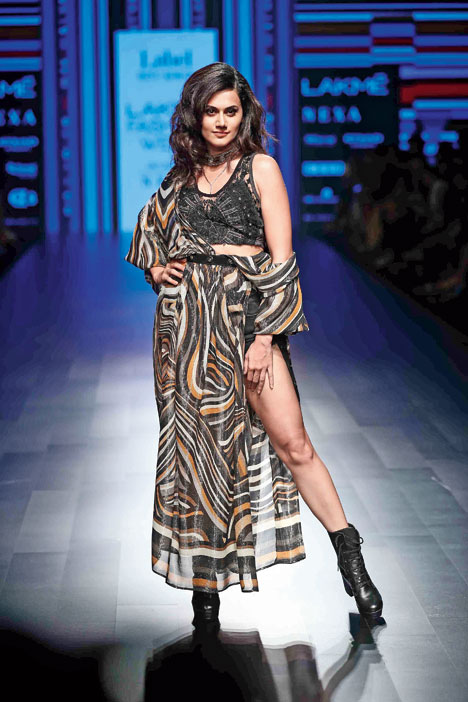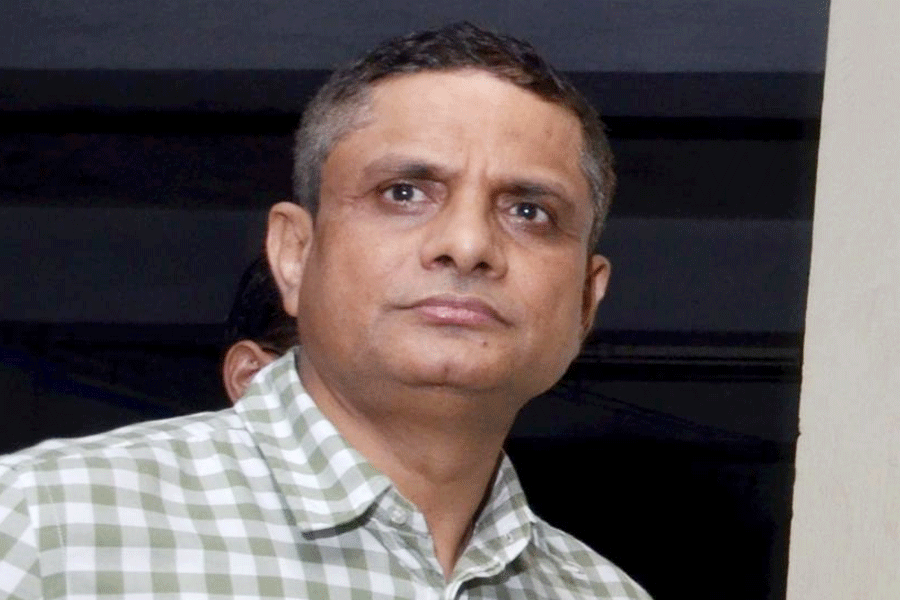
Picture: Sandip Das
When I started out…
There wasn’t any concept of designer clothes. There wasn’t any concept of retailing. There were no shops for clothes. You can’t even think of an India like that. There were some sari shops but those were mostly Bengal handloom-type saris. There was no organised retail in this country. The British were just sending down the fabrics printed in Lancashire, with Indian prints, and selling them to the wholesalers. And people used to buy those fabrics and get their garments made. It was as basic as that. This was sometime in the Sixties.
I was an art history student and I thought I would probably end up being an artist. I moved to Calcutta from Delhi after marriage and I went to Ashutosh Museum (of Indian Art in Calcutta) to do my History of Museology course. Part of the course was an archaeology dig in Chandraketugarh, outside Calcutta, and that took me to the districts.
So when I went to the districts, I saw in Serampore little bit of hand-block printing happening, in another area this zardozi work happening, but in a very, very poor way… I happened to be in the handloom areas as part of my History of Art course and I just happened to find this immense handicraft tradition which was completely lost! Like in Serampore, people were printing silks with blocks that had polka dots on them… the thing was it had to look as if it was rotary-printed. No one was interested in their crafts anymore, in immediately post-colonial India. And that really bugged me.
I said show me your old blocks… beautiful paisleys and butas and butis they used to do… and I started reviving that. I did a small revival of saris in Serampore with the hand-block printers. I sketched the blocks for them; not much of the old designs were available anywhere… maybe they were there in museums but there was no reference material one could use.
When the first batch of saris started coming out, I took them to Cottage Industries. I took them to the few places I knew which had retail. They were mostly government places and it was difficult to get through to them. So by default, I opened a little store on Wellesley Street (now Rafi Ahmed Kidwai Road) in 1968, which was a big grocery store and they gave me half of it. Through that I started selling these saris. It’s a complete accident that I am in this business.
Then they started producing some beautiful saris and one little store was not enough. I had a cousin who had a garage and then we opened the second store in their garage. From there started the story. The retail has gone places but my interest in crafts remains and has expanded to many more areas.
It was a struggle…
Because in India at that time, your course books didn’t have any Indian references. I got a scholarship to study in Briarcliffe College in America and there, I went through a fairly intensive Art History course, learning classical Western crafts and art. When the teacher would turn around to me and say, ‘Of course in your country there’s a huge crafts heritage’, I didn’t have a clue. I used to feel hugely inadequate. In the evenings I would go to the library and locate books on Indian art. When I came back, I started going to museums to read up on Indian crafts.
Unlike in Europe, where art is put into one bracket and craft in a different bracket, in India it totally overlaps. Like if you have a particular design on a temple architecture, you’ll find the same design on a block on a sari. So I actually got into textiles by accident through the art route. I am still doing that and trying to make it viable for fashion in India, so that the organic nature of Indian textiles gets the exposure that is due to it.

The first exhibition I had…
Of hand-block printed saris was at The Park. I had studied the textiles of about five places including Rajasthan, Bengal and Andhra Pradesh, and put together about 30 saris with painstaking effort. The first two days, except for one or two friends who couldn’t help it and had to buy, it was the biggest flop. They hated the saris. Because that was the time of the Calcutta races and all the women were wearing chiffons and pearls. And there I was with this ethnic thing. They would tell me, ‘You know, this is looking like my grandmother’s bedcover.’ I was so excited, I was like ‘Really? That is what I am trying to make it look like!’ But it was not taken kindly.
Then I realised the mistake I had made — I had put the designs on khadi! I put the same designs on chiffon and they became a raging hit. Then Surat printers copied us, the Benaras printing houses copied us… and then you started seeing the same borders and pallus and butas on saris and fabrics.

I had very strong support…
From Pupul Jayakar (cultural activist) and Kamaladevi Chattopadhyay (social activist). Pupul got me to exhibit my saris in Lalit Kala Academy… Mrs (Indira) Gandhi opened that exhibition. Then there was this phase when a lot of women were going through crafts revival. Not only on textiles but a variety of crafts. So we were like a group. We were encouraged to go to Farrukhabad by Jayakar, discover old block printers… then we used to go to Jaisalmer, Andhra… in a way we also discovered India through its textiles. Initially I think I was running like a cottage industry (laughs)… it wasn’t anything to do with fashion.
The cottage industry…
Could not be supported for long. The two retail shops in Calcutta were there, but they were there for fun actually. My husband was in another business and I loved doing this, so I was doing this. But it had absolutely no commercial validity on its own steam, because India was not what India is today.
Then one day from nowhere came this lady from Trade Action, this NGO from Australia who were wanting to do natural fabrics. She came to the store on Wellesley Street and saw the saris and wanted to meet me. I met her and she said, ‘Can you make these into scarves?’ So I made her about 20-30 scarves. And then she came back with an order for 7,000 scarves. I was like I have only two block tables, how can I do this? My husband was listening to me, he was like, are you crazy? Why are you refusing this? Surely somebody can produce this. So he sent out people to the fields, they discovered lots of idle workshops that took the order, and there was no turning back.
After that we got into hand-block print exports in a large way. And that became the foundation for the retail trade. That brought us designers from abroad, that brought us people who could cut and sew. I remember when we got an order for 400 garments, we did not know how to make a garment (laughs); we didn’t have pattern-makers. So my whole story is based on the success of the exports venture.

I don’t manage my business
The business is still managed by the company my husband created for the exports. That business has also grown phenomenally… we used to only export to France and London initially, then we started exporting to America in a very big way. So that infrastructure has grown… and the growth of my retail network is almost a reflection of that growth. We have that venture all over the world… America, France, Japan, Australia, South Africa… that doesn’t necessarily have anything to do with handicrafts or handwork. But that organisation was set up, which is being replicated in a fairly efficient way in India with my chain of retail stores. My work is really to do the collections only.
The exports venture also helped with the standard procedure to do the business. Like our sizing standard… only thing is we had to study the Indian body types to do the sizing accordingly. So there are experts in the field who come and do that study for you.
My son Amrish joined the company when Label was launched and is the one who is making the retail expansion happen. He has a very good eye for fashion. I try not to interfere in that apart from the textile part, where he needs help. That’s on its own feet now.

The three brands that I have...
Are actually made for different areas of the market. There is one international-looking brand, which is the Label… for a much younger person but with an Indian soul. It’s for people who don’t want to wear a sari any longer… they want to wear well-cut and finished stuff.
The RK brand was actually the original brand, where the silhouettes are very much a part of our textiles, and that will always be for a classic person. We created that classic brand and that’s what we want it to be… we don’t want to make that brand into T-shirts… it should stay in that lounge wear, club wear space.
Ri is almost 100 per cent Calcutta-based. We have set up so many embroidery bases, we’ve got so many craftspeople who work for that. That brand is going to stay consistent with what is best of handcrafted that comes out of India. So there are very clear distinctions.
.jpg)
Our price points are affordable…
Because I most definitely feel that if you have a great design, it does not mean that only two people should be able to afford it. I think there is a very strong aesthetic in the Indian textile world. I think we need a handwriting which is Indian and it should permeate across the country. Part of the CSR of our company is to pick up one or two areas and make sure they also come up to the level where they can also expand. Like the ikat work that we are doing, the embroidery we are doing in Bengal…. So that diffusion is only possible if your prices are not wild. Also, we don’t do one-of-a-kind… it’s a policy of the company… we create something that can be dispersed.

The unexplored craft areas are…
Too many. I have driven down widely across the country and every five villages you would find some craft… because these were crafts that were used as barter… between the potter and the weaver and so on… and every area would have a certain handwriting. Like Santiniketan saris are different from Shantipur saris or Phulia saris. Kanjeevaram is completely different from Pochampally saris… so we have the richest vocabulary in the world in textiles. Even sitting in Calcutta, you have a weaving district, you have an embroidery district and you have a printing district… there is no other place with that kind of intense craftsmanship. So Bengal was my first… then Rajasthan and Kutch I did in-depth.
There are more craft areas that have not been explored than there are ones that have been talked about. Today it’s happening… and to a large extent I give credit to the younger designers. They are creating things from these pockets which are now being noticed.
I am working with Odisha ikat extensively… they have the tradition of weaving Gita Govinda into fabrics that are used as temple hangings.
I want to go to South… that’s one area we haven’t explored… it’s going to be a huge challenge to do something better than they already do. But it is not better that I am looking for, what I am looking for is it to become market-friendly. Like, I don’t want to re-do a classic Kanjeevaram, except maybe they are making it stiff now by using Chinese yarn and lurex… it doesn’t flow, they don’t use the correct Bhagalpur silk… all this doesn’t take long to correct if there’s a project on. I also want to go to Chettinad… they do these check saris in cotton, there’s something lovely about them. Kashmir I am working on, big time… there’s a revival going on there also.
As one of the most-copied designers…
I just keep ahead of the game. There’s no other way to do it. In any space if you are creating something and the market is liking it, then the only way to continue doing it is to keep ahead of the line. We have taken so many people to court but that’s just for the record. If I look at what we did 30 years back and what we are doing today, maybe it’s within the same ethos, but it still has moved much forward. So that’s it — you get better than what you did before.
— Smita Roy Chowdhury










